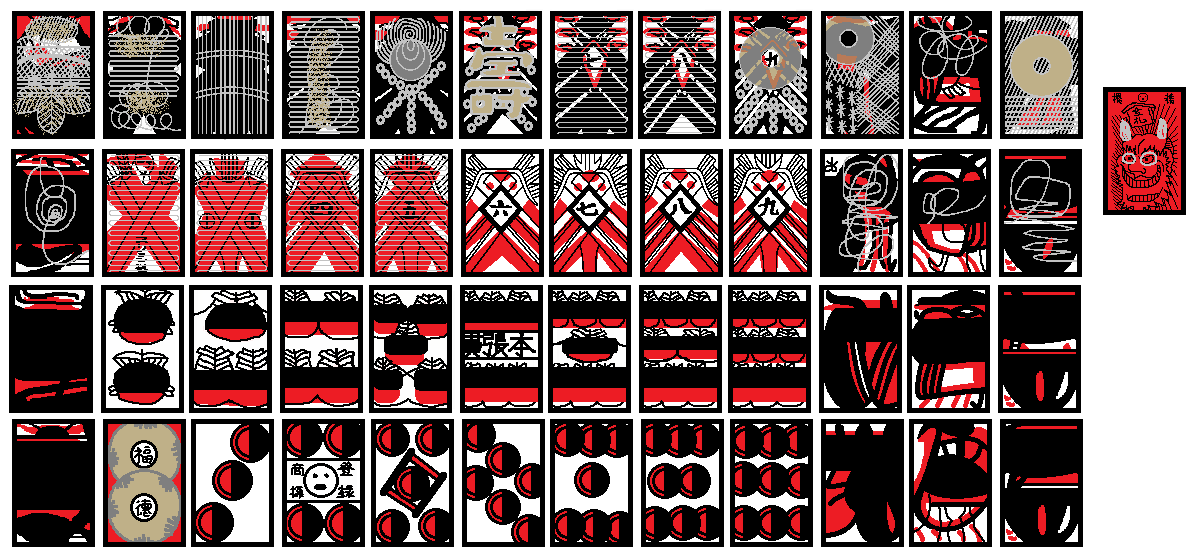
Mekurifuda [めくり札], or Mekuri Karuta [めくりかるた], are a type of Japanese karuta (playing cards) that were directly derived from Tensho Karuta [天正かるた], which were faithful copies of Portuguese playing cards (Nanban Karuta [南蛮カルタ]).
There were many different Mekurifuda patterns depending on the region of Japan, but all of them consisted of 48 cards, and were structurally the same as a Portuguese playing card deck.
The name comes from the game Mekuri, a game which was thought of as a predecessor to Hana-Awase, but has actually coexisted with the latter. However, these cards are not strictly used for Mekuri games only.
One-suited Mekurifuda decks were subsequently developed, which were designed for simpler betting games.
These card decks were subject to bans due to their association with gambling, which is also banned. Those caught in the act of gambling would be punished, or even put to death. Despite the bans, the use and gambling of karuta continued.
There was a theory that gamblers turned to other kinds of cards such as Hanafuda as a way to get around the bans. However, historical evidence suggests that games played using Hanafuda and games played using Mekurifuda coexisted, and there is also a theory that mekurifuda was used to play hanafuda games, not the other way around.
For a list of games played using these cards, see Mekurifuda Games.
¶ History
See History of Playing Karuta in Japan
The history of Mekurifuda could be traced back to the Tensho era (1573-1592) when the Japanese first manufactured copies of Portuguese playing cards domestically. Nowadays, these domestic products are classified as Tensho Karuta, after the era in which they started to be made.
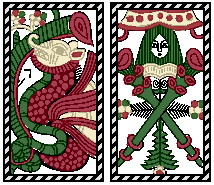
They proved to be popular among the Japanese people, although their use in gambling caught the ire of the ruling authorities. Bans were enacted, especially during the reign of the Tokugawa Shogunate (1603-1868). Those caught gambling with them were fined, imprisoned, punished, or even put to death. Stores that were openly selling karuta were ordered to stop selling and dismantle their stores. Nevertheless, people kept playing and gambling with karuta undercover. Manufacturers continued to produce karuta in the underground market.
Another problem with Tensho Karuta is that it featured foreign imagery that could be mistaken for Christian iconography, especially the suit of cups which looked like the Holy Grail. This was considered dangerous, since Christianity was formally banned since 1602, and any person caught practicing Christianity was immediately put to death. A person owning a Karuta deck could be accused of being Christian and executed.
Considering this, it seemed that karuta manufacturers tried to cover up or change the iconography of Karuta. They replaced the courts with illustrations suitable for Japanese tastes, such as images of Samurai or Buddhist iconography. Eventually, manufacturers heavily overprinted them with color or transformed them into abstract shapes or strokes, likely as a way to reduce costs.
The resulting Karuta decks slightly varied in design and structure depending on the region in Japan it was made, and the kind of game that was popular in those regions. These types of cards were given various names based on the games played with them, such as “Tensho Karuta”, “Yomi Karuta”, “Mekuri Karuta”, “Kingo Karuta”, “Kabu Karuta”, etc., but because of the similarities in their structure and design, they are now all classified as Mekurifuda.
¶ Deck Overview
Just like a Portuguese playing card deck, there are 4 suits in a Mekurifuda deck - clubs, swords, cups, and coins. There are 12 ranks of cards: Dragon, 2, 3, 4, 5, 6, 7, 8, 9, Maid, Horse, and King. In some decks, a joker card is used, called Onifuda (‘demon card’) or Bakefuda (‘monster card’).

Some Mekurifuda patterns have gold and silver overprints to differentiate which card is which suit and to identify the point values of cards when playing Mekuri.
¶ Names of Suits
| English names |
Portuguese names |
Japanese names |
Japanese nicknames |
|---|---|---|---|
| Clubs | Paus | Hau / Pau | Ao (‘Blue’) |
| Swords | Espadas | Isu | Aka (‘Red’) |
| Cups | Copas | Koppu / Kotsu | Kuchibiru (‘Lips’) / Kappa |
| Coins | Ouros | Oru / Ouru | Taiko (‘Drums’) / Tama (‘Orbs’) |
¶ Numbers and Courts
| Number | English names |
Japanese names |
Notes |
|---|---|---|---|
| 1 | Dragon/Ace | Pin/Tsun/Un Mushi Aza |
Pin is the kabu term for ‘one’, and likely has Portuguese origins. Tsun also likely has Portuguese origins. Un from Portuguese Um meaning ‘one’. Mushi is a Japanese word meaning ‘insect’. Aza from Portuguese As meaning ‘ace’, refering specifically to the Dragon of Clubs. |
| 2 | Two | Ni | - |
| 3 | Three | San | - |
| 4 | Four | Shi/Yon | - |
| 5 | Five | Go | - |
| 6 | Six | Roku | - |
| 7 | Seven | Nana/Shichi | - |
| 8 | Eight | Hachi | - |
| 9 | Nine | Ku/Kyu | - |
| 10 | Maid | Juu/Tou/Sota | Juu/Tou means ‘ten’ in Japanese. Sota is exactly the Portuguese term meaning ‘servant’. |
| 11 | Horse/Knight | Uma/Kaba | Uma means ‘horse’ in Japanese. Kaba is a shortening of Portuguese cavalo (‘horse’) or cavaleiro (‘horseman’). |
| 12 | King | Kiri/Rei | Kiri is likely a shortening of Latin Christus. Rei is exactly the Portuguese term meaning ‘king’. |
¶ Kinds of Mekurifuda
| Pattern | Played in | Description |
|---|---|---|
| Akahachi | Kyoto, Osaka, Kobe, Tanba, Tango, Tajima, Yamato, Kawachi, Izumi, Settsu, and Banshu | Swords and Cups suits are made of thin lines, and Courts have faces drawn, and were colored with thin lines. Clubs: 1 has an elaborate paulownia and cloud overprint. 2, 10, 11, and 12 are elaborately overprinted. 3, 4, 5, and 6 have X marks on the clubs. 6 has a gold 壽 (kotobuki, ‘longevity’) on it. Swords: 8 has two gold rings on it. Coins: 1 has lines and squiggles. 2 has two gold rings on it. 3, 4, and 5 have a circled X on each coin. 6 is colored gold, and is elaborately overprinted with silver. Comes with a white “Onifuda” It is the only mekurifuda deck that also came with a red back as well as a black back. |
| Ise | Omi, Mino, Iga, Ise, Shima, Owari | Swords and Cups suits are made of thin lines; Coins are smaller than usual. Courts have faces drawn, and were colored with thin lines. There are no overprints on the cards. Comes with “Bakefuda”. |
| Fukutoku | Toyama, Uozu, Fushiki, Himi, Etchu province, Echizen, Kaga, Noto, and Shinano Town | Cups are round. Clubs: 1 has an elaborate paulownia and cloud overprint. 2, 10, 11, and 12 are elaborately overprinted. 2, 3, 4, 5, 9, 10, and 12 have elaborate squiggles, lines, and/or designs that stand out from the deck. 6 has a gold 壽 (kotobuki, ‘longevity’) on it. 7 and 8 have thin horizontal lines. 11 has squiggles. Swords: 1, 10,11 and 12 has squiggles (11 having the smallest squiggle). 2, 3, 4, and 5 has thin horizontal lines. Coins: 2 has two gold rings on it. Comes with a red “Onifuda” |
| Kingyoku | - | Cups are round, and courts have faint humanoid characteristics. Clubs: 1 has an elaborate paulownia and cloud overprint. 2, 10, 11, and 12 are elaborately overprinted. 4 has a gold windchime with a sakura flower underneath. 5 has patterns related to wax gourds. Swords: 1 has lines and squiggles Coins: 2 has two gold rings on it. Comes with a red “Onifuda” |
| Kojishi | - | Cards are smaller than usual, and has four “Onifuda”. All clubs, swords, and the 2 of Coins are overprinted. |
| Kurofuda; a.k.a Tsugarubana | Tsugaru, Rikuzen, Rikuchu, and Ugo province | Colors on all cards are applied very thickly, as if to hide the designs underneath (courts resemble humans). There are no overprints on the cards. Comes with a red “Onifuda” |
| Kurouma | Suruga, Shizuoka, Hokkaido | Design is identical to Fukutoku except the 2 of Coins has a Black horse on the top coin and 本 on the bottom coin. The 2 of coins is also overprinted with gold rings. There was a screw-up between the black and red overprints and the outline drawings of the Maids and the Horses; All 10 (Maids) of Swords, Cups and Coins have outline drawings of Horses, while all 11 (Horses) of Swords, Cups and Coins have outline drawings of Maids! |
| Mitsuogi | Echigo, Wakasa, Omi, Etchu, Echizen, and Hokkaido | Design is identical to Fukutoku and Kurouma, but the dragons and courts are drawn slightly differently and with very faint humanoid characteristics. Also,the 2 of Coins has three golden hand fans with a red sun on each of them, arranged in a circle on the top coin, while the bottom coin is black and overprinted with a feather-like pattern inside the circle. |
| Komatsu | Echizen, Tsuruga, Takefu, Fukui, Mikuni-Minato, and Kishu | Swords and Cups suits are made of very thin lines; Coins are very small dots. Courts and dragons are all abstract, made up of thin black and red strokes. There are no overprints on the cards. Comes with a red “Onifuda”. |
| Sakuragawa | Hokuriku Region | Swords and Cups suits are made of thick lines; Cups are round. Courts and dragons are drawn, but are completely obscured by thick strokes of black and red. There are no overprints on the cards. Does not come with any Onifuda. |
¶ Cards that Mimicked a Mekurifuda deck
¶ Shimafuda
Shimafuda (島札, lit. “Island Cards"), also known as Jifuda (字札, lit. “Character Cards”) or Ichi-Ni-San (一二三, lit. “One Two Three”, not to be confused with the game of the same name) is a type of Mekurifuda derivative that remained in Gushikawa, Uruma City, in the Okinawa prefecture of Japan. It is used to play a game of the same name.
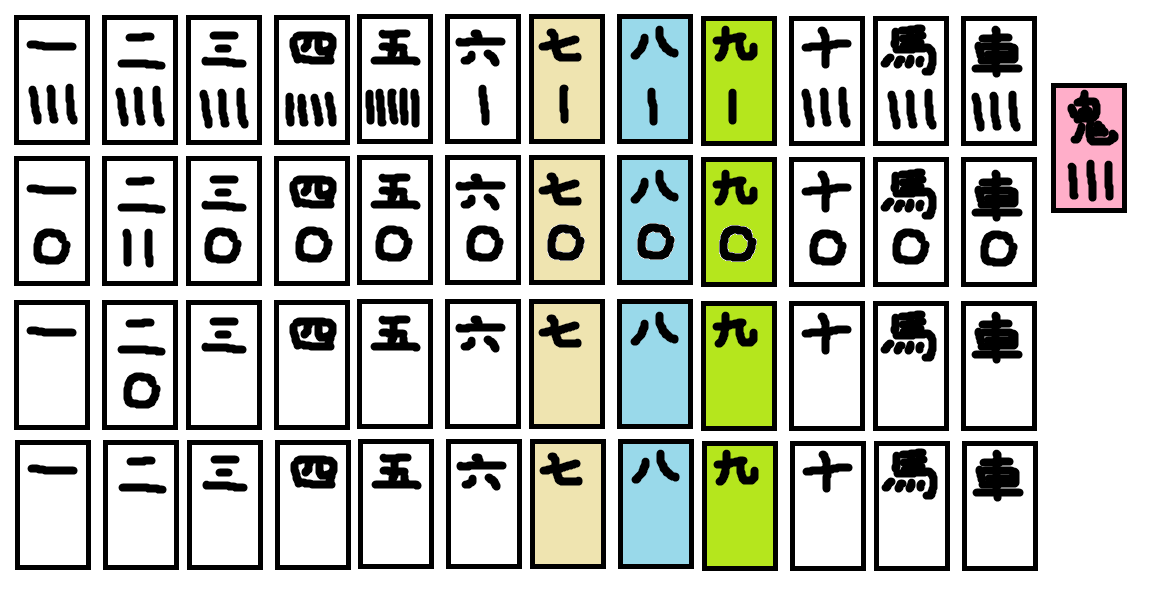
The cards do not bear any Portuguese-derived designs; instead, numbers were represented by kanji on the upper half of each card, and points were represented by sticks or circles on the lower half of each card.
However, the structure of the deck is consistent with mekurifuda decks, with the number 2 having three cards with points on them (In a mekurifuda deck, the number 2 has three scoring cards: the 2 of Clubs, 2 of Swords, and 2 of Coins).
Also, cards with circles on the lower half correspond to the Swords suit of mekurifuda decks, while cards without markings on the lower half correspond to the Junks of mekurifuda decks.
¶ Hanafuda
Hanafuda can be used to mimic a mekurifuda deck. Each flower represents a month of the year, which actually corresponds to a number in a mekurifuda deck.
The standard month sequence can be used in games where the type of cards rarely matter, such as Yomi-type, Kabu-type, and Kingo-type games. However, in games where the exact structure of a mekurifuda deck is required, the Nagoya month sequence is used, as described below.
| Mekurifuda Number |
Hanafuda Month |
Flower Icon |
Flower Name |
|---|---|---|---|
| 1 (Dragon) | January | Pine | |
| 2 | February | Willow | |
| 3 | March | Cherry Blossom | |
| 4 | April | Wisteria | |
| 5 | May | Iris | |
| 6 | June | Paulownia | |
| 7 | July | Bush Clover | |
| 8 | August | Susuki Grass | |
| 9 | September | Chrysanthemum | |
| 10 (Maid) | October | Maple | |
| 11 (Horse) | November | Peony | |
| 12 (King) | December | Plum Blossom |
In the Nagoya month sequence, four of the months were shuffled about. The purpose seems to be so that the Willow suit, which has three scoring cards, takes the role of the number 2 in a mekurifuda deck, which also has three scoring cards (it is also worth mentioning that it is impossible to play certain mekuri games with a hanafuda deck if the standard month sequence is used, unless one junk of each month is marked to distinguish it from the other), and that the Phoenix card takes the role of the 6 of Clubs in a mekurifuda deck, which is usually overprinted with a gold 壽 (kotobuki, ‘longevity’).
The highest scoring card of each month (except for Willow; it’s the Swallow card) correspond to the Clubs suit of mekurifuda.
The ribbons, as well as the Geese card and the yellow Paulownia chaff, correspond to the Swords suit of mekurifuda.
The Rainman corresponds to the 2 of Coins.
Other cards correspond to the Junks of mekurifuda.
¶ Gallery
| Pattern | The Deck |
|---|---|
| Akahachi | 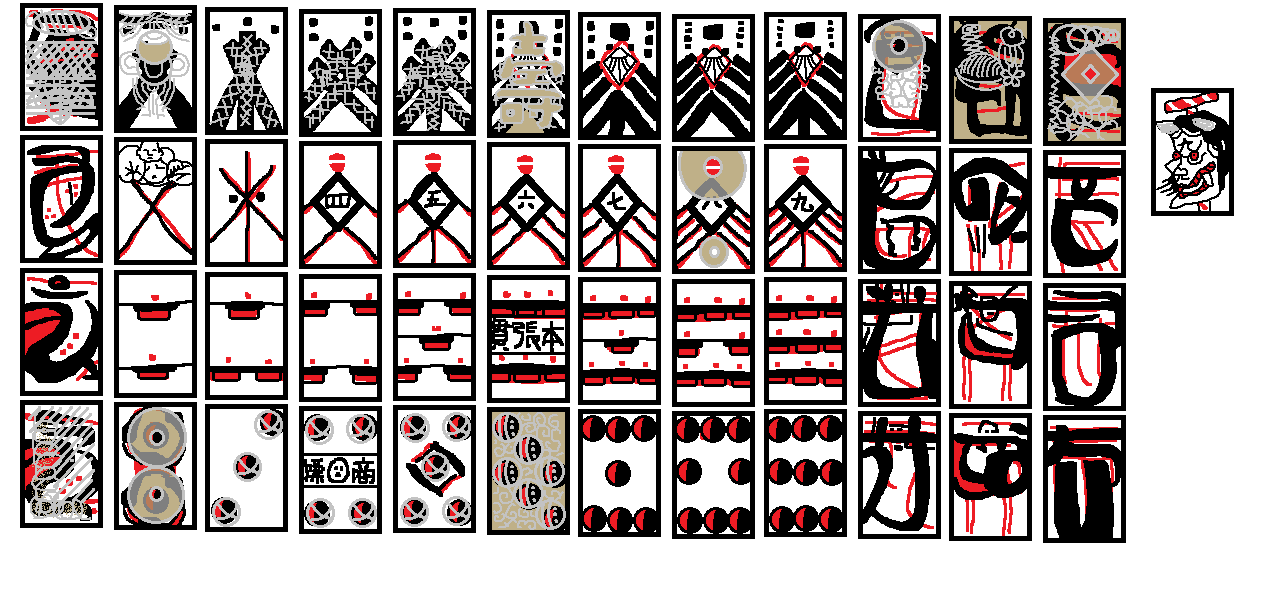 |
| Ise | 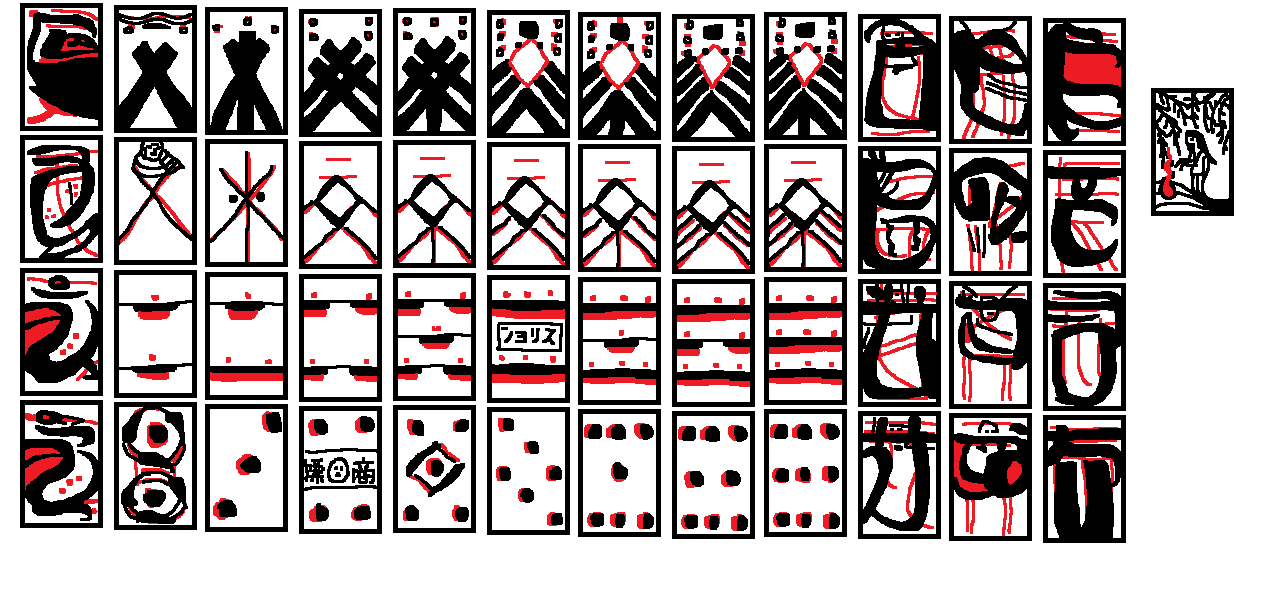 |
| Fukutoku |  |
| Kingyoku | 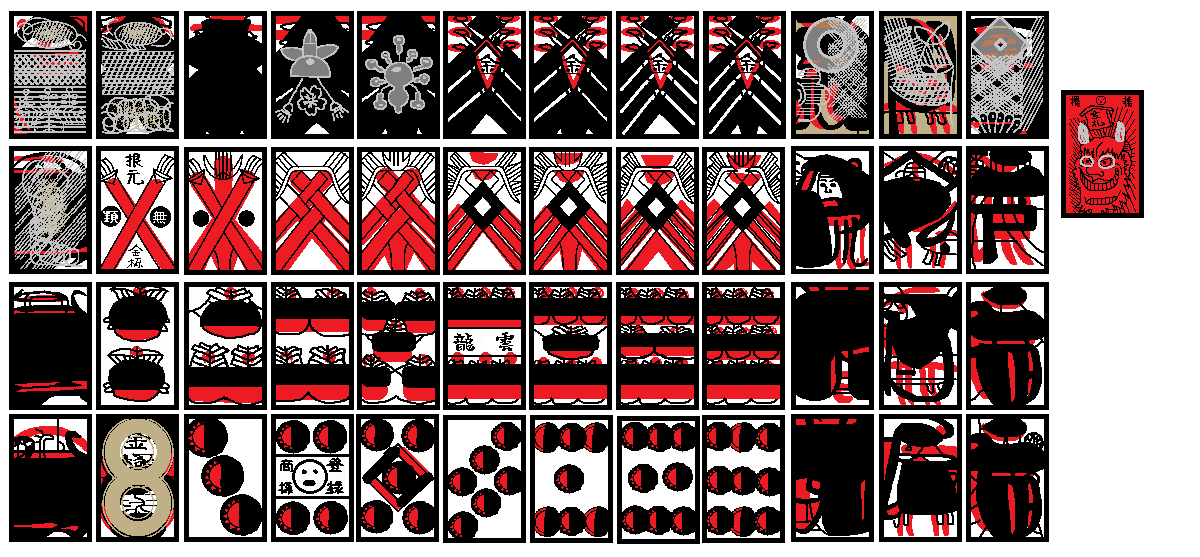 |
| Kurofuda; a.k.a Tsugarubana | - |
| Kurouma | - |
| Mitsuogi | - |
| Komatsu | 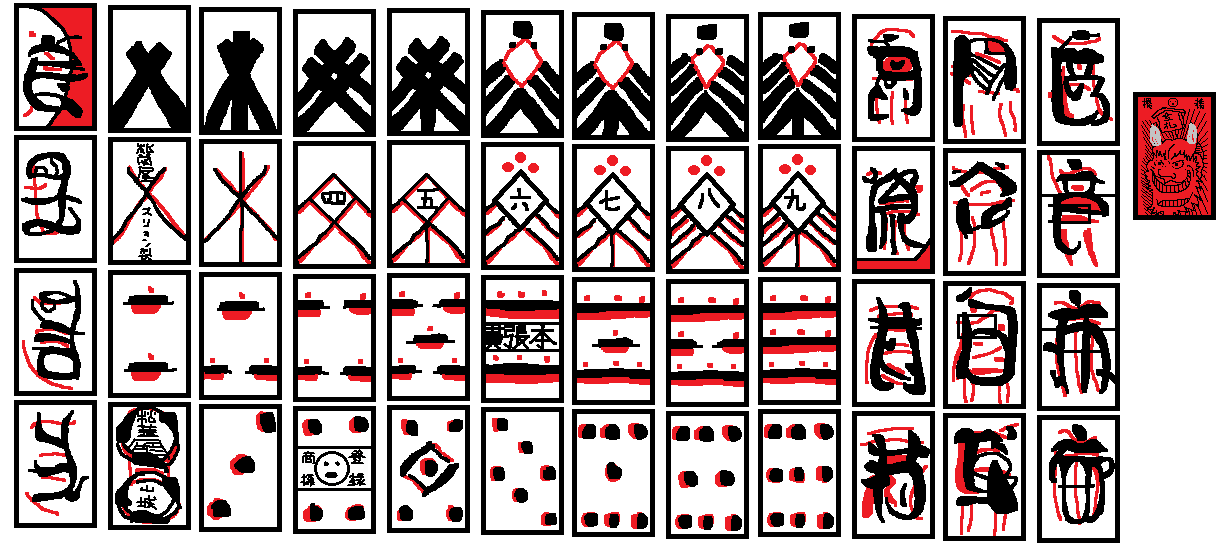 |
¶ Bibliography
- https://ja.wikipedia.org/wiki/天正かるた
- https://l-pollett.tripod.com/cards37.htm
- Nintendo Brands and Chiho-fuda poster, Late Taisho to Early Showa era.
- https://japanplayingcardmuseum.com/1-2-4-0-jan-cock-blomhoff-two/
- https://en.wikipedia.org/wiki/Francis_Xavier
- https://en.wikipedia.org/wiki/San_Felipe_incident_(1596)
- https://en.wikipedia.org/wiki/Kirishitan